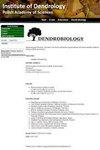气候变化下中欧低地环境因子及管理对混交林动态的影响
IF 1.8
4区 农林科学
Q2 FORESTRY
引用次数: 7
摘要
捷克共和国为自然演替保留的混合低地森林稀少。然而,它们的发展为了解这些森林的自然过程提供了重要的见解,并为气候变化中的森林管理提出了建议。该研究基于2002年、2008年、2014年和2020年的库存,描述了卡尔什特因国家自然保护区(捷克)角木橡树林和石灰质山毛榉为主的森林的动态、生产力、结构、多样性、枯木和径向生长。目的是评估2004年让不同管理的林分(高林、有标准的矮林和矮林)自发发展后的变化。从2002年到2014年,树木密度增加了2-10%,2020年减少了6-18%。在高海拔森林中,整个时期都观察到林分体积的增加,而在有标准和矮林的矮林中,直到2014年才观察到。2020年,林分面积从190(矮林)到630(高林)m³ha−1不等,18年来平均增长了28%。乔木层的总体多样性在高林中表现出不均匀的结构,在其他变体中表现出显著的多样性结构。枯木量一直在稳步增加(2020年为18-35 m³ha−1),平均累积1 m³ha–1 yr−1。6月至8月缺乏降水和高温是树木径向生长的主要限制因素,而在过去十年中,负指标年数有所增加。与有弹性的欧洲白蜡树(Fraxinus excelsior L.)相比,欧洲山毛榉(Fagus sylvatica L.)是对气候最敏感的树种。在7-15年的温度周期中,挪威枫(Acer platanoides L.)的直径增量波动最小,山毛榉树的直径增量变化最高。在过去的20年里,无柄橡树[Quercus petraea(Matt.)Liebl.]的径向生长增加了7%,而其他树种的径向生长减少,山毛榉的径向生长最大(减少了-38%)。作为高森林管理的林分具有较高的生产潜力和较低的多样性,与标准和矮林相比,其动态较慢。本文章由计算机程序翻译,如有差异,请以英文原文为准。
Effects of environmental factors and management on dynamics of mixed calcareous forests under climate change in Central European lowlands
Mixed lowland forests reserved for natural succession are sparse in the Czech Republic. However, their development provides essential insights into the natural processes of these forests and recommendations for forest management in a changing climate. The research describes the dynamics, productivity, structure, diversity, dead wood, and radial growth of hornbeam-oak groves and calcareous beech-dominated forests in the Karlštejn National Nature Reserve (Czechia) based on inventory in 2002, 2008, 2014 and 2020. The objective was to evaluate changes in differently managed stands (high forest, coppice with standards, and coppice) after leaving the stands to spontaneous development in 2004. The tree density increased by 2–10% from 2002 to 2014 and decreased by 6–18% in 2020. In the high forest, an increase in the stand volume was observed during the whole period, while in the coppice with standards and coppice, only until 2014. The stand volume ranged from 190 (coppice) to 630 (high forest) m³ ha−1 in 2020 and increased by an average of 28% over 18 years. Overall diversity of tree layer showed an uneven structure in the high forest and a substantially diverse structure in the other variants. The deadwood volume has been steadily increasing (18–35 m³ ha−1 in 2020), accumulating an average of 1 m³ ha−1 yr−1. A lack of precipitation and high temperatures from June to August were the main limiting factors of the radial growth of tree species, while the number of negative pointer years has increased in the last decade. European beech (Fagus sylvatica L.) was the most sensitive tree species to climate compared to the resilient European ash (Fraxinus excelsior L.). The lowest fluctuations in the diameter increment were recorded in Norway maple (Acer platanoides L.) and the highest in beech in the temperature cycles of 7–15 years. Over the last 20 years, sessile oak [Quercus petraea (Matt.) Liebl.] showed an increase in radial growth by 7%, while other tree species reported a decrease with a maximum in beech (by −38%). The forest stands managed as high forest, characterized by a higher production potential and lower diversity, had slower dynamics when compared to coppice with standards and coppice.
求助全文
通过发布文献求助,成功后即可免费获取论文全文。
去求助
来源期刊

Dendrobiology
农林科学-林学
CiteScore
2.20
自引率
11.10%
发文量
17
审稿时长
>12 weeks
期刊介绍:
Dendrobiology publishes original research articles and review articles related to the biology of trees and shrubs.
 求助内容:
求助内容: 应助结果提醒方式:
应助结果提醒方式:


